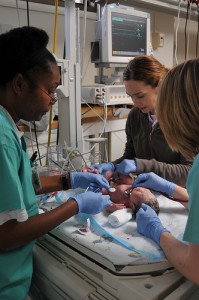
Sepsis, a serious, hard-to-diagnose threat in the NICU, can interfere with a baby's development even when cleared with antibiotics. (Image: Army Medicine/Flickr)
Sepsis, or bacterial infection of the bloodstream, is a grave threat to premature infants in the neonatal intensive care unit (NICU) who have catheters and intravenous lines. Even when antibiotics clear the infection itself, the inflammation that it causes can do just as much damage. Not only can sepsis and the resulting inflammation interfere with fragile preemies’ ability to gain weight, but a growing literature suggests that they can impair brain development.
Preventive measures can now avoid many cases of sepsis, but those that slip through can be hard to detect in newborns.
“Newborns can’t speak, and they have unique immune systems, so they tend not to have fevers or show clinical signs,” explains Ofer Levy, MD, PhD, of the Division of Infectious Diseases at Boston Children’s Hospital. “There may be irregular breathing or increased heart rate, or the baby may be acting a little ‘off,’ but these signs are pretty nonspecific. There’s a tremendous need for better diagnostics in this field.”
Levy and colleagues recently described a mouse model that, for the first time, captures the effects of sepsis on the newborn immune system. They and others have begun using it to identify diagnostic markers and better treatments. Full story »








